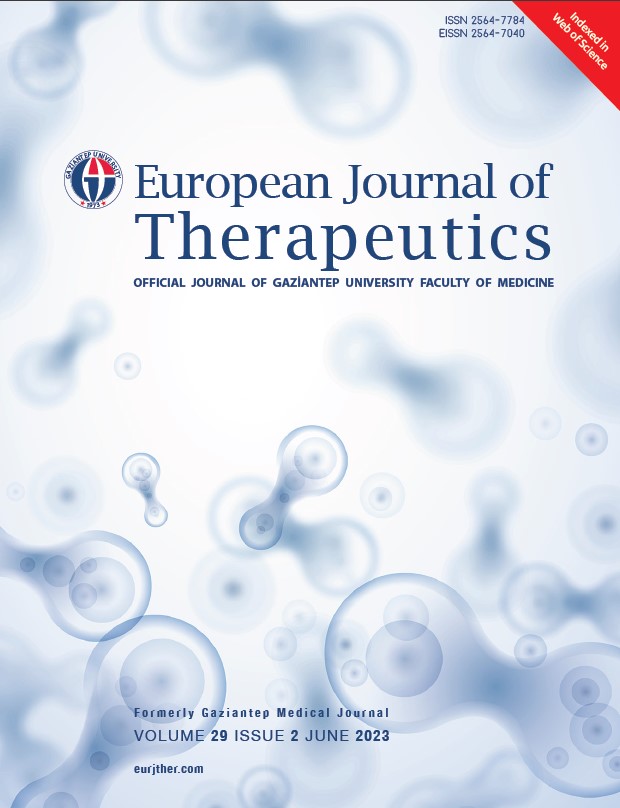Does Inferior Oblique Muscle Overaction Affect Ocular Vestibular Evoked Myogenic Potentials?
DOI:
https://doi.org/10.58600/eurjther.20232902-451.yKeywords:
o-Vemp, strabismus, inferior oblique muscle hyperfunction, balance, vertigoAbstract
Objectives: Inferior oblique muscle overaction (IOOA) is a common ocular motility disorder. Ocular Vestibular Evoked Myogenic Potentials (oVEMP) are tests that evaluate the reflex pathway between the utricular macula and the inferior oblique muscle to detect vestibular diseases. Our study is of great importance as it is the first study in the literature to evaluate the effect of inferior oblique muscle overaction on oVEMP parameters.
Methods: Thirty-five patients with unilateral inferior oblique muscle overaction (IOOA group) and 18 healthy volunteers without any neurological or vestibulocochlear disease were included in this study. All patients and healthy volunteers were evaluated with oVEMP.
Results: No statistically significant difference was found between the n1 latency, p1 latency, n1-p1 latency measurement values of the participants included in the study (p>0,05). A statistically significant difference was found between the n1-p1 amplitude measurement values of the participants in patient groups (non-squint eyes, squint eyes) and control groups (p-value was 0.038).
Conclusion: In IOOA patients, vestibulo-ocular reflex pathway may be affected, vestibular symptoms may develop thus o-VEMP responses may be affected. A careful anamnesis should be taken in IOOA patients, and it should be kept in mind that n1-p1 amplitudes and asymmetries may be significantly higher when o-VEMP is performed
Keywords: o-VEMP, Strabismus, Inferior oblique muscle overaction, Balance, Vertigo
Metrics
References
Alajbegovic-Halimic J, Zvizdic D, Sahbegovic-Holcner A, Kulanic-Kuduzovic A (2015) Recession vs Myotomy-Comparative Analysis of Two Surgical Procedures of Weakening Inferior Oblique Muscle Overaction. Med Arch. (Sarajevo, Bosnia Herzegovina) 69:165–8. https://doi.org/10.5455/medarh.2015.69.165-168
Sanjari MS, Shahraki K, Nekoozadeh S, Tabatabaee SM, Shahraki K, Aghdam KA (2014) Surgical Treatments in Inferior Oblique Muscle Overaction. J Ophthalmic Vis Res. 9:291–5. https://doi.org/10.4103/2008-322X.143355
Chang BL, Yang SW (1988) Inferior oblique overaction. Korean J Ophthalmol. 2:77. https://doi.org/10.3341/kjo.1988.2.2.77
Wilson ME, Parks MM (1989) Primary Inferior Oblique Overaction in Congenital Esotropia, Accommodative Esotropia, and Intermittent Exotropia. Ophthalmology. 96:950–7. https://doi.org/10.1016/s0161-6420(89)32774-6
Moon K, Lee SY (2006) The effect of graded recession and anteriorization on unilateral superior oblique palsy. Korean J Ophthalmol. 20:188–91. https://doi.org/10.3341/kjo.2006.20.3.188
Özsoy E (2020) Surgical management of primary inferior oblique muscle overaction: a subgroup-specific surgical approach. Beyoglu Eye J. 5:38–42. https://doi.org/10.14744/bej.2020.81904
Rosengren SM, Welgampola MS, Colebatch JG (2010) Vestibular evoked myogenic potentials: Past, present and future. Clin Neurophysiol. 121:636–51. https://doi.org/10.1016/j.clinph.2009.10.016
Murofushi T (2016) Clinical application of vestibular evoked myogenic potential (VEMP). Auris Nasus Larynx. 43:367–76. https://doi.org/10.1016/j.anl.2015.12.006
Godha S, Upadhyay Mundra A, Mundra RK, Bhalot L, Singh A (2020) VEMP: An Objective Test for Diagnosing the Cases of BPPV. Indian J Otolaryngol Head Neck Surg. 72:251–6. https://doi.org/10.1007/s12070-020-01802-3
Manzari L, Tedesco AR, Burgess AM, Curthoys IS (2020) Ocular and cervical vestibular-evoked myogenic potentials to bone conducted vibration in Ménière’s disease during quiescence vs during acute attacks. Clin Neurophysiol. 121:1092–101. https://doi.org/10.1016/j.clinph.2010.02.003
Chihara Y, Iwasaki S, Murofushi T, Yagi M, Inoue A, Fujimoto C, Egami N, Ushio M, Karino S, Sugasawa K, Yamasoba T (2012) Clinical characteristics of inferior vestibular neuritis. Acta Otolaryngol. 132:1288–94. https://doi.org/10.3109/00016489.2012.701326
Fu W, Wang Y, He F, Wei D, Bai Y, Han J, Wang X (2021) Vestibular and oculomotor function in patients with vestibular migraine. Am J Otolaryngol. 42:103152. https://doi.org/10.1016/j.amjoto.2021.103152
Hassannia F, Misale P, Harvey K, Yu E, Rutka JA (2021) Elevated ocular VEMP responses in the absence of a superior semicircular canal dehiscence. Am J Otolaryngol. 42:102789. https://doi.org/10.1016/j.amjoto.2020.102789
Korres SG (2014) Contribution of Vestibular-Evoked Myogenic Potential (VEMP) testing in the assessment and the differential diagnosis of otosclerosis. Med Sci Monit. 20:205–13. https://doi.org/10.12659/MSM.889753
Maia N de PD, Lopes K de C, Ganança FF (2020) Vestibular evoked myogenic potentials in the prognosis of sudden hearing loss a systematic review. Braz J Otorhinolaryngol. 86:247–54. https://doi.org/10.1016/j.bjorl.2019.10.001
Shimizu K (2020) Vestibular evoked myogenic potentials in multiple sclerosis. J Neurol Neurosurg Psychiatry. 69:276–7. https://doi.org/10.1136/jnnp.69.2.276
Murofushi, Hideki Takegoshi T (2000) Vestibular Evoked Myogenic Potentials in Patients with Spinocerebellar Degeneration. Acta Otolaryngol. 120:821–4. https://doi.org/10.1080/000164800750061660
Chen C-H, Young Y-H (2003) Vestibular Evoked Myogenic Potentials in Brainstem Stroke. Laryngoscope. 113:990–3. https://doi.org/10.1097/00005537-200306000-00014
de Natale ER, Ginatempo F, Paulus KS, Manca A, Mercante B, Pes GM, Agnetti V, Tolu E, Deriu F (2015) Paired neurophysiological and clinical study of the brainstem at different stages of Parkinson’s Disease. Clin Neurophysiol . 126:1871–8. https://doi.org/10.1016/j.clinph.2014.12.017
Nguyen KD, Welgampola MS, Carey JP (2010) Test-retest reliability and age-related characteristics of the ocular and cervical vestibular evoked myogenic potential tests. Otol Neurotol. 31:793–802. https://doi.org/10.1097/MAO.0b013e3181e3d60e
Ochi K, Ohashi T (2003) Age-related changes in the vestibular-evoked myogenic potentials. Otolaryngol - Head Neck Surg. 129:655–9. https://doi.org/10.1016/s0194-5998(03)01578-x
Chihara Y, Iwasaki S, Ushio M, Fujimoto C, Kashio A, Kondo K, Ito K, Asakage T, Yamasoba T, Kaga K, Murofushi T (2009) Ocular vestibular-evoked myogenic potentials (oVEMPs) require extraocular muscles but not facial or cochlear nerve activity. Clin Neurophysiol. 120:581–7. https://doi.org/10.1016/j.clinph.2008.12.030
Huang Y-C, Yang T-L, Young Y-H (2012) Feasibility of ocular vestibular-evoked myogenic potentials (oVEMPs) recorded with eyes closed. Clin Neurophysiol. 123:376–81. https://doi.org/10.1016/j.clinph.2011.06.024
Bayram A, Kalkan M, Ünsal N, Kale A, Küçük B, Mutlu C (2018) Does blindness affect ocular vestibular evoked myogenic potentials? Am J Otolaryngol. 39:290–2. https://doi.org/10.1016/j.amjoto.2018.03.010
Govender S, Rosengren SM, Colebatch JG (2009) The effect of gaze direction on the ocular vestibular evoked myogenic potential produced by air-conducted sound. Clin Neurophysiol. 120:1386–91. https://doi.org/10.1016/j.clinph.2009.04.017
Rosengren SM, Colebatch JG, Straumann D, Weber KP (2013) Why do oVEMPs become larger when you look up? Explaining the effect of gaze elevation on the ocular vestibular evoked myogenic potential. Clin Neurophysiol. 124:785–91. https://doi.org/10.1016/j.clinph.2012.10.012
Sandhu JS, George SR, Rea PA (2013) The effect of electrode positioning on the ocular vestibular evoked myogenic potential to air-conducted sound. Clin Neurophysiol. 124:1232–6. https://doi.org/10.1016/j.clinph.2012.11.019
Singh NK, Kadisonga P, Ashitha P (2014) Optimizing stimulus repetition rate for recording ocular vestibular evoked myogenic potential elicited by air-conduction tone bursts of 500 Hz. Audiol Res. 4:88. https://doi.org/10.4081/audiores.2014.88
Downloads
Published
How to Cite
License
Copyright (c) 2023 European Journal of Therapeutics

This work is licensed under a Creative Commons Attribution-NonCommercial 4.0 International License.
The content of this journal is licensed under a Creative Commons Attribution-NonCommercial 4.0 International License.


















